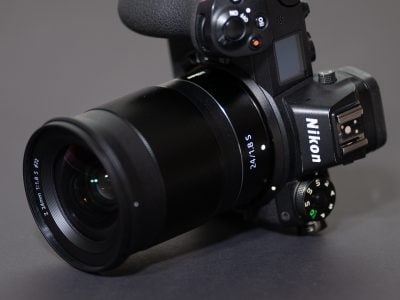Nikon Z 24mm f1.8 S review
-
-
Written by Thomas
Intro
The Nikon Z 24mm f1.8 S is a wide-angle prime lens for Nikon’s Z-series mirrorless cameras of DX or FX format: on a cropped body like the Z50 the lens is equivalent in angle-of-view and depth-of-field to a 35mm f2.8 lens. On a full-frame body the Z 24mm f1.8 S is the widest Z-mount prime lens with autofocus you can get at the time of writing, giving a clearly broader angle-of-view than Nikon’s Z 35mm f1.8 S without being prone to some of the distortions that a 20mm lens can produce. The wide coverage lets you capture more of architecture or landscapes while the bright aperture lets you shoot longer under diminishing light and better isolates closer subjects from the background compared to f2.8 or f4.0 zooms. But thanks to Nikon’s FTZ adapter, existing F-mount lenses can alternatively be easily used on the new Z bodies. So the new Z 24mm f1.8 S faces competition from a host of other wide angle lenses with the F-mount, most notably Nikon’s own AF-S 24mm f1.8G.
As the Z 24mm f1.8 S is a member of Nikon’s high-end “S” line it is expected to perform on a very high level. To find out whether the new Nikon Z 24mm f1.8 S rightfully carries the “S” moniker I tested its optical qualities on the 45MP Z7 body against a few other lenses of which the Zeiss 28mm f1.4 Otus is my current reference wide angle lens. So if you’re interested in how Nikon’s widest prime lens (so far) for their new Z system performs, you’ve come to the right place! PS – if you’re interested in the other Z lenses in Nikon’s line-up check out our in-depth reviews: Nikon Z 14-30mm f4.0 S review / Nikon Z 24-70mm f2.8 S review / Nikon Z 24-70mm f4 S review / Nikon Z 35mm f1.8 S review / Nikon Z 50mm f1.8 S review / Nikon Z 58mm f0.95 S Noct review / Nikon Z 85mm f1.8 S review.
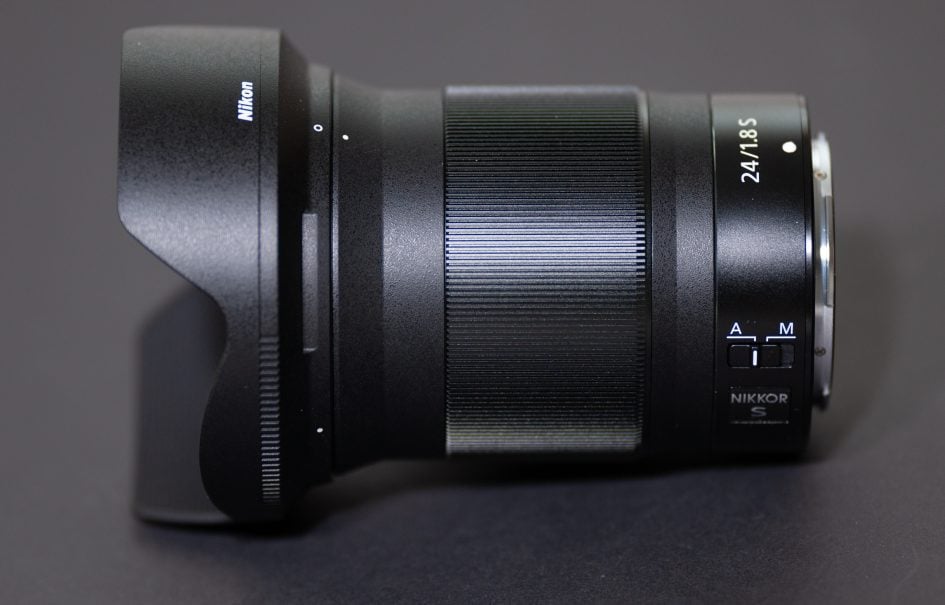
Facts from the catalog
As usual I’ll have a look at the technical data of the new Nikon Z 24mm f1.8 S first. I’ve rated the features with a [+] (or [++]), when it’s better than average or even state of the art, a [0] if it’s standard or just average, and [-] if there’s a disadvantage. For this comparison I use the Nikon AF-S 24mm f1.8G (“F Nikkor” for short) and the Sigma 24mm f1.4 Art (“Sigma”). Please keep in mind that the Sigma has a 2/3 of a stop brighter focal ratio which influences size and weight of that lens
Size (diameter x length): 78 x 97mm (3.1 x 3.8in.). The lens hood adds 34mm and is 98mm in diameter. The F Nikkor is 78 x 83mm and the Sigma is 85 x 90mm (both without lens hood). For an apples-to-apples comparison one has to allow for the differences of flange distance between the Z-mount (16mm) and the F-mount (46.5mm). So these 30.5mm (1.2in.) have to be added when using the F Nikkor or the Sigma when mounting it via the FTZ adapter on a Z7. [0]
Weight: 447g (15.9 oz.) plus 23g for the lens hood. The F Nikkor is 355g (12.5 oz.), the Sigma 665g (23.5 oz.) without lens hood plus another 133g (4.7 oz.) for the FTZ adapter to use it on a Z7. [0]
Optics: 12 elements (including one special dispersion and 4 aspherical elements) in 10 groups which is similar to the F Nikkor. The Sigma is a more complex design with 15 elements in 11 groups. The new Nikon Z 24mm f1.8 S uses Nikon’s Nano-Coating to reduce flare, glare and ghosting. [+]
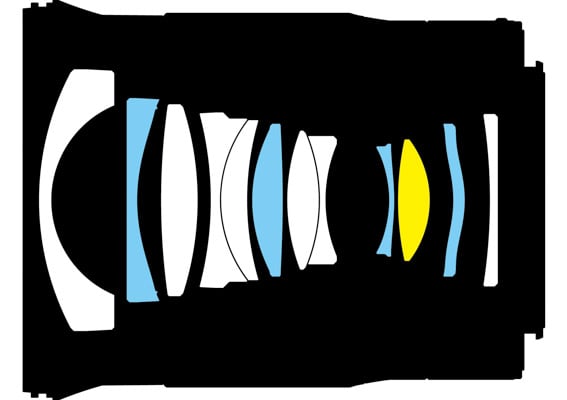
Closest focus distance is 0.25m (0.82ft.) with a magnification of 1:6.7. In my test I was able to get down to 1:5.7 at 0.23m with manual focus. The magnification of the new Nikon is not bad but you have only 12cm (4.7in.) of working distance at minimum focus distance. A magnification of 1:10 is achieved at 0.32m giving a working distance of 17cm with lens hood attached. The F Nikkor achieves 1:5 in manual focus, the Sigma 1:5.3. [0]
Filter-thread: 72mm same as the Nikon Z 24-70mm f4.0S and the F Nikkor. The Sigma is 77mm. [+]
Image stabilization: The lens offers no optical stabilization. But the Nikon Z bodies provide built-in sensor-shift stabilization over 5 axis – plus an optional electronic stabilization in video mode. The F Nikkor and the Sigma have no optical image stabilization built in but the body-based image stabilization of a Nikon Z7 body provides roll, pitch, and yaw correction. [0]
Auto focus: Yes, with built-in AF drive. Manual-focus override is by simply turning the focus ring – if you didn’t assign another operation to this multi-function ring. The focus ring has a variable gearing that allows for very precise manual focus when turned slowly. Unfortunately this feature cannot be switched to linear gearing which makes smooth focus pulling for videographers almost impossible. Focus on the F Nikkor and the Sigma works similarly with the only differences being a direct linear gearing and that the focus ring does only that: focusing. Which comes with the benefit of a distance- and dof-scale. [+]
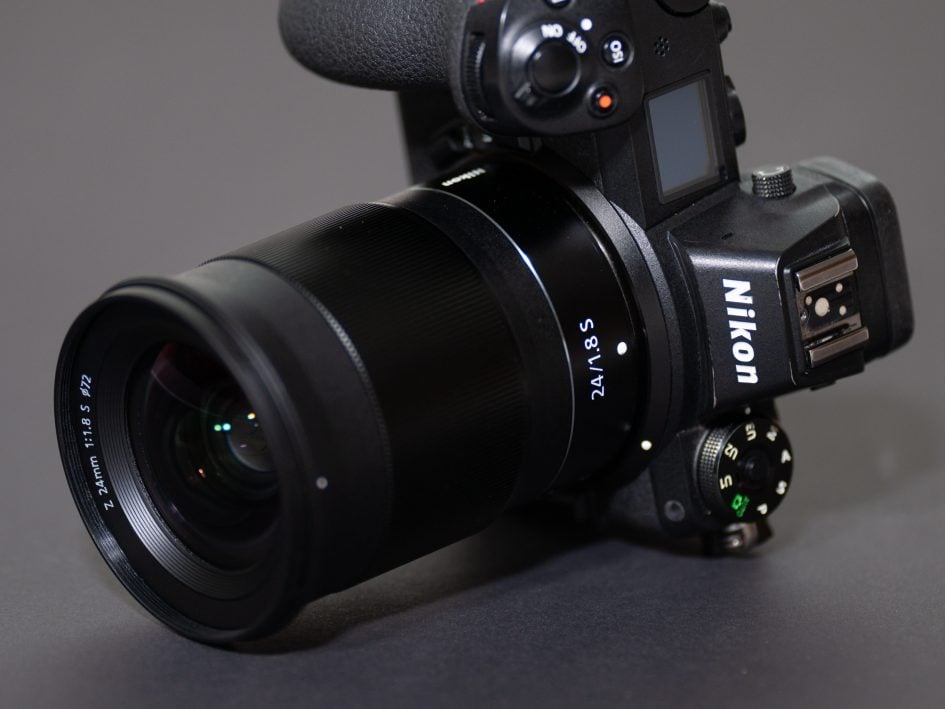
Covers full frame/FX or smaller. Same with the alternatives. [+]
Price: The lens is pretty expensive at a list price of 1200 EUR (incl. 19% VAT) / 1000 USD. The F Nikkor goes for 700 EUR / 750 USD, the Sigma is at 700 EUR / 850 USD. [-]
Comes with a soft pouch and the lens hood is included, reversible for transport. That’s similar to the F Nikkor but I must say the new pouches for the Z lenses are disappointing: the material is flimsy and the pouch has no strings to pull it close. So if you put the lens in your bag it might easily slip out of its pouch and bang around unprotected. The Sigma has a nice well-padded case. [0]
Aperture ring: the multi-function control ring of an S-lens can be assigned to operate the aperture, exposure compensation or focus. It automatically falls back to its customary focus control when the lens is switched to manual focus. Although the lens control ring has not the same benefit as having a focus ring plus a dedicated aperture ring on the lens it gives you more flexibility to control one of the more important shooting parameters directly from a nice ring on the lens. The F Nikkor and the Sigma don’t have an aperture control ring. [+]
Sealing: yes, a rubber grommet at the lens-mount plus further special weather-sealing throughout the construction. Both the F Nikkor and the Sigma only have the sealing at the lens-mount [+]
The score in the “features-department” is 1[-]/5[0]/6[+]. So the lens has a mixed feature set: It’s neither very small nor very light but it offers the nifty feature of the multi-purpose control ring and is sealed against the weather like Nikon’s pro lenses. But then it costs a pretty penny.
Three ways to go 24mm on a Nikon Z camera
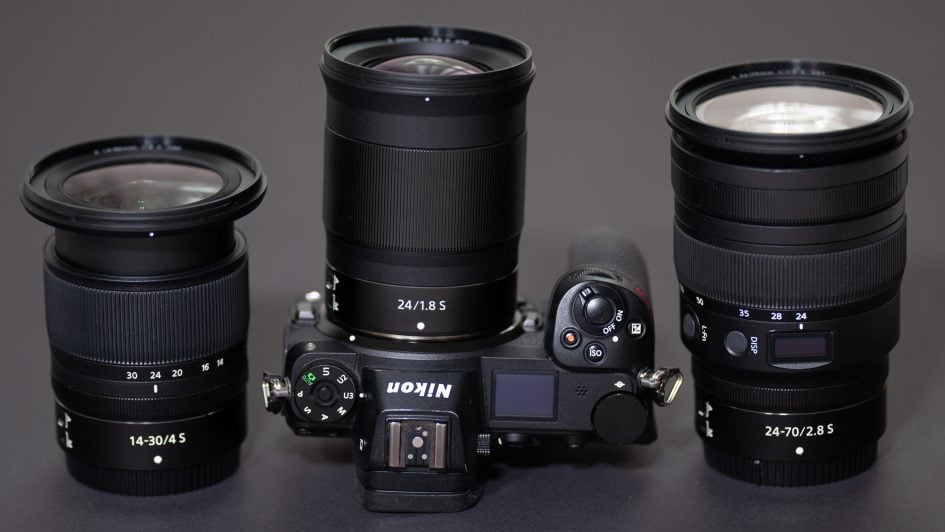
Above from left to right: Nikon Z 14-30mm f4.0 S, Nikon Z 24mm f1.8 S, Nikon Z 24-70mm f2.8 S
Alternatives
The market for wide-angle prime lenses is pretty crowded but no other manufacturer offers a 24mm lens for Nikon’s Z-mount so far. So for alternatives we have to look at F-mount lenses which can be used via Nikon’s FTZ adapter – adding another 31mm in length and 133g in weight. But still there is only one other 24mm f1.8 lens:
- Nikon has the AF-S 24mm f1.8G ED from 2014 for 700 EUR / 750 USD. For more information see my Nikon 24mm f1.8G review where it got a recommendation.
The other choices include either going wider to 20mm (offering 10 degrees wider angle of view) or longer to 28mm (offering an 1.17 crop resp. larger magnification while losing 9 degrees of coverage) or getting lenses with a 2/3 of a stop brighter focal ratio of f1.4 which are all bigger, heavier and normally more expensive than their f1.8 counterparts:
- Nikon offers the AF-S 20mm f1.8G from 2014. It costs 660 EUR / 800 USD and came recommended in my Nikon 20mm f1.8G ED review.
They also have the AF-S 28mm f1.8G from 2012 (630 EUR / 700 USD) which earned a recommendation in my Nikon 28mm f1.8G review. The problematic focus shift of this lens should be eliminated by the feature of the Nikon Z cameras to focus stopped down.
Plus there is the AF-S 24mm f1.4G ED from 2010 for 1900 EUR / 2000 USD which came Highly Recommended in my Nikon 24mm f1.4G ED review. - Sigma offers the AF 24mm 1.4 DG HSM Art from 2012 for a relatively low price of 750 EUR / 900 USD. See my Sigma 24mm f1.4 Art review where it came Highly Recommended.
- The Zeiss 28mm f1.4 Otus from 2015 is my current reference wide-angle prime lens. But it costs a whopping 4000 EUR / 5000 USD – and it’s manual focus only! But its build quality is unsurpassed and the optical performance is top notch. It earned a Highly Recommended in my Zeiss Otus 28mm f1.4 review.
Zeiss also offers the manual-focus Milvus 25mm f1.4 for 2000 EUR / 2400 USD. - There’s also a bunch of Samyang/Rokinon/Walimex 24mm f1.4 lenses for F-mount. Some of them are designed for video use but none has autofocus.
Finally you might also consider the Nikon Z 24-70mm f2.8 S as an alternative. It has the benefit of covering a 2.9x zoom range covering a wide array of very useful focal lengths at a constant f2.8 focal ratio. It is larger and heavier than the Z 24mm f1.8 S, but it does not need an adapter like the other alternatives above, and offers very good optical performance which got it a Highly Recommended in my Nikon Z 24-70mm f2.8 S review. But at 1900 EUR / 2300 USD it doesn’t come cheap either.
Focus
Focus accuracy and repeatability is critical to consistently produce sharp shots especially with large aperture lenses. Repeatability (the accuracy of focus on the same subject after repeated focus-acquisition) of this lens is very good (measured 99.0% in Reikan FoCal) with no outliers over a series of 40 shots. There is no focus variation whether the lens focuses from a closer distance or from infinity.
The lens focuses in around 0.5 sec from infinity to 0.32m (1:10 magnification), which is pretty fast. Hunting didn’t occur under the well-lit test conditions. The focus/control ring is 38mm wide. Its surface is not rubberized but as it moves super smooth and can easily be operated even with your pinky the finely knurled metal surface is well up to its task.
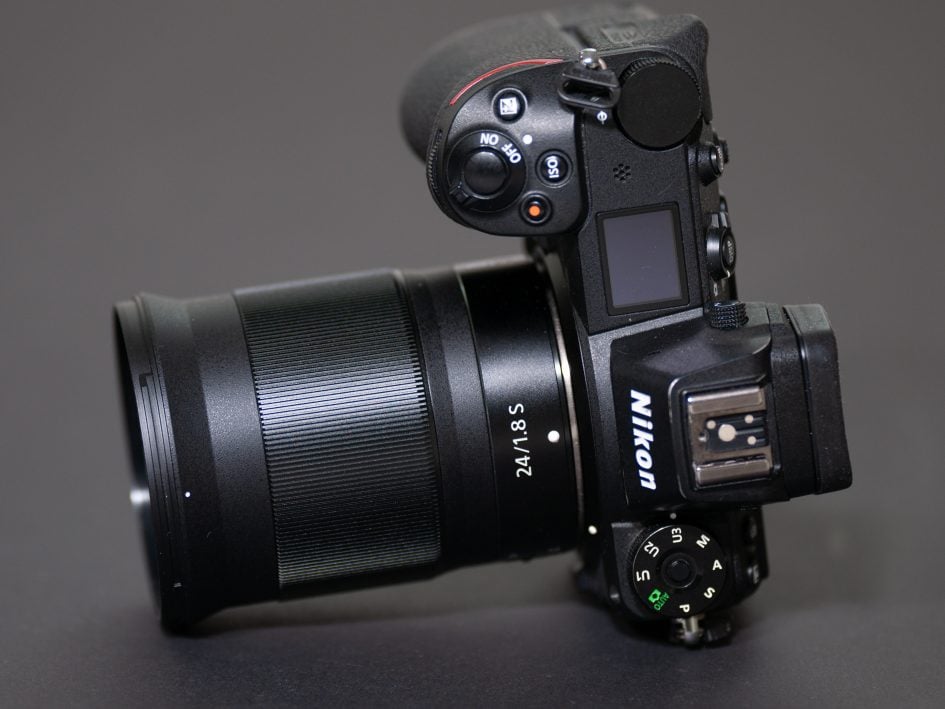
AF-operation of the lens is barely audible from the outside. But if you record video with the built-in microphone the AF-drive still produces a slight buzz. This lens is clearly not as quiet as the Nikon Z 24-70mm f4S. If you use the control ring on the lens to change the aperture this works smoothly and without noise.
The lens is free of focus breathing: when I adjusted the focus from infinity to 0.32m on the new Z Nikkor, I measured only a very small 0.3% increase in magnification. This should please videographers.
Next check out my quality results!
Check prices on the Nikon Z 24mm f1.8 S at Amazon, B&H, Adorama, or Wex. Alternatively get yourself a copy of my In Camera book or treat me to a coffee! Thanks!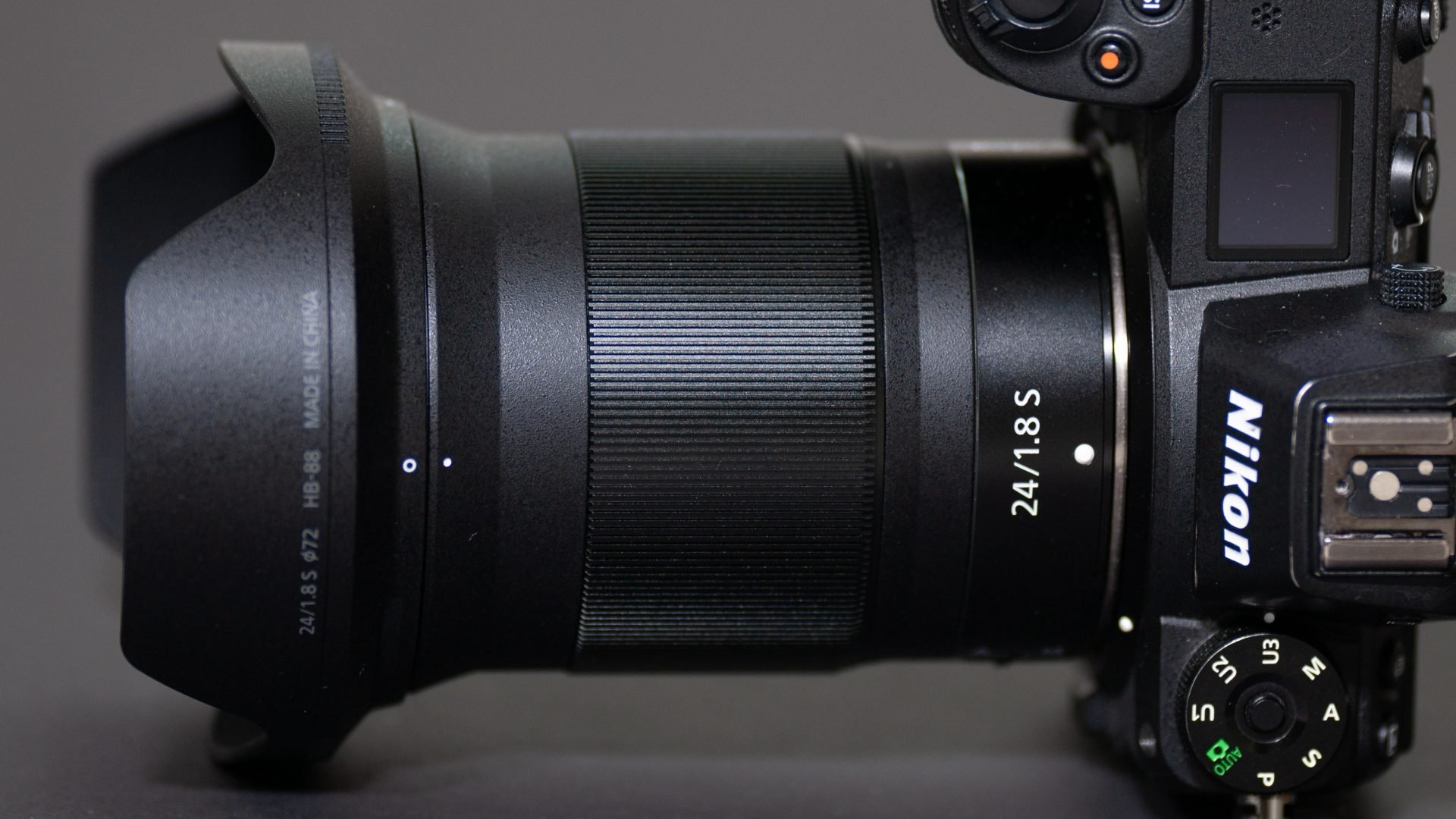
 The Nikon Z 24mm f1.8 S is a very good wide angle prime lens for owners of Z-series mirrorless bodies: Resolution and contrast is as good or even better than the Zeiss 28mm f1.4 Otus - which is no small feat. It also delivers usable close-up performance when stopped down a little and retains its high contrast exceptionally well even in contra-light situations. Plus its size and weight makes it a good match for the compact Z-series bodies it's designed for. The new Z Nikkor also focuses fast and reliably and is sealed thoroughly against the elements. Its longitudinal color aberrations could be lower but didn't stand out in real-life shooting, and the Bokeh is quite smooth for a 24mm f1.8 lens. All-in-all the Z 24mm f1.8 S performs better than the Nikon Z 35mm f1.8 S and is neck-and-neck with the Zeiss Otus 28mm f1.4. This deserves a Highly Recommended - provided you get a well-centered copy!
The Nikon Z 24mm f1.8 S is a very good wide angle prime lens for owners of Z-series mirrorless bodies: Resolution and contrast is as good or even better than the Zeiss 28mm f1.4 Otus - which is no small feat. It also delivers usable close-up performance when stopped down a little and retains its high contrast exceptionally well even in contra-light situations. Plus its size and weight makes it a good match for the compact Z-series bodies it's designed for. The new Z Nikkor also focuses fast and reliably and is sealed thoroughly against the elements. Its longitudinal color aberrations could be lower but didn't stand out in real-life shooting, and the Bokeh is quite smooth for a 24mm f1.8 lens. All-in-all the Z 24mm f1.8 S performs better than the Nikon Z 35mm f1.8 S and is neck-and-neck with the Zeiss Otus 28mm f1.4. This deserves a Highly Recommended - provided you get a well-centered copy!



